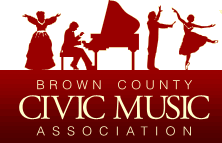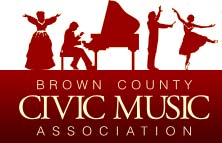Program | Season Listing | Biographies
Chamber Orchestra Kremlin brings passion and artistry to the Ralph Holter Auditorium as we open our series with one of Russia’s most heralded chamber ensembles. Sponsored by the George Kress Foundation, Inc.
Program
- Gioacchino Rossini (1792-1868)
Sonata in C major, No. 3 (1804)- Allegro
- Andante
- Moderato
- Sergei Prokofiev (1891-1953)
Visions Fugitives, Op. 22 (1915-1917)
(Arranged for string orchestra by Rudolf Barshai) - J.S. Bach (1685-1750)
Concerto in D minor for Two Violins, BWV 1043- Vivace
- Largo ma non tanto
- Allegro
- Soloists from the orchestra will perform.
- Intermission
- W.A. Mozart (1756-1791)
Divertimento in D major, K. 136 (1772)- Allegro
- Andante
- Presto
- Piotr Ilyich Tchaikovsky (1840-1893)
Serenade for Strings, Op. 48 (1880)- Pezzo in forma di sonatina: Andante non troppo – Allegro moderato
- Valse: Moderato. Tempo di Valse
- Elegie: Larghetto elegiaco
- Finale (Tema Russo): Andante – Allegro con spirito
Program Notes
©Misha Rachlevsky
Gioacchino Rossini — Sonata in C major, No. 3
Summer, vacation time. You rent a cottage in the country and take your family there “to get away from it all”. Your 12 year old, getting a bit bored already on the second day, powers up the notebook computer, and before you know it, creates a computer game that challenges and entertains the participants, while giving much pleasure to the spectators. Ask for a copy of this program and keep the diskette in a safe place – you never know.
After the Second World War, Alfredo Casella found in the Library of Congress a 150-year-old manuscript with this inscription: “The scores of these dreadful sonatas, composed by me on holiday at the home (near Ravenna) of my friend Agostino Triossi when I was at a most infantile age, not even having taken a lesson in counterpoint, the whole composed and copied out in three days and played like dogs by Triossi, double bass, Morini (his cousin), first violin, the latter’s brother, cello, and myself on second violin, who was, to tell the truth, the least doggish.” The ease and generosity with which the melodic material unfolds in this and his other sonatas suggests that 12-year-old Rossini did not have to overly exert himself to produce these marvels. A smile is never more than a few seconds away, and there is an unmistakable presence of operatic elements, giving hint of what would one day blossom into magnificent stage works.
Today these sonatas are extremely popular both on stage and in the recording studio, performed mainly in string orchestra version. The recording of an integral set of Six Sonatas for Strings is Chamber Orchestra KREMLIN’s most celebrated disc to date, having won both the Repertoire and Diapason d’Or awards in Paris and Gramophone’s Critics Choice award in London.
Prokofiev — Visions Fugitives, Op. 22
Years ago I read a cute account of one’s visit to a concert hall which, in essence, went like this: “On the program there was Bruckner’s Symphony No. xx. Musicians gathered on stage and the light was dimmed, but still strong enough to glance through the program booklet, which I did. Then, some time later, the majestic melody began unfolding, filling the hall and capturing everybody’s attention. It was the main theme of the first movement, and it was gorgeous. By that time the poor violins had been playing tremolo non stop for at least 15 minutes”. Bruckner’s symphonies were aptly called “Cathedrals of sound”, and to hold the structure, one indeed needed a foundation of proportional might. One of the major challenges to the performers of this music is to hold this structure as a whole, without losing sight of its dimension. In day-to-day language, the composition should not feel too long.
The challenge of writing and performing miniatures is directly the opposite in nature, as the limited time should not feel insufficient to define the work’s emotional characteristics. Prokofiev succeeded magnificently, writing Visions Fugitives as a piano cycle of 20 miniatures. The average length of each is about one minute, and some as short as 20 seconds. Barshai transcribed 15 of them for string orchestra. They are great fun to perform and, hopefully, to hear.
J.S. Bach — Concerto in D minor for Two Violins
The two violins of J. S. Bach’s Concerto, BWV 1043, are like a pair of birds swooping through the skies, flying in a merry race, first one leading, then the other. The strings and continuo are there as the branches of a tree, offering the birds a place to alight briefly, but it’s those teasing, dueling violins that are the show. The violins hardly rest at all, but they take off at a breakneck speed, embroidering lacy patterns in sound, coming to a halt only when they’re done. (Imagine those elaborate domino pictures where one domino starts the action, and the lines of chips fall, racing along until the entire picture is revealed. That’s BWV 1043.) This piece dates from Bach’s tenure at Cöthen between 1717 and 1722. Prince Leopold was fond of music, and the post of Kapellmeister was an advance in Bach’s career. To get to Cöthen, though, Bach had to spend some time jailed by his then-employer, Duke Wilhelm, who was furious that Bach would attempt to leave his job at Weimar and attempted to keep him captive. (Program notes provided by Bach Festival Society, Winter Park FL)
Mozart — Divertimento in D, K. 136
Written in Salzburg in January 1772, Mozart’s Divertimenti K. 136-138 were scored for string quartet, and research suggests that they were composed in preparation for Mozart’s upcoming second journey to Italy. Most likely they were intended to be used as pleasant “filler” numbers for some occasions (a somewhat unsettling thought, but, nevertheless, true – these and other Divertimenti, as well as numerous Serenades and Cassations were written for and performed at garden parties and similar occasions as purely background entertainment – 18th century elevator music, if you will). Researchers have also determined that the title Divertimento in the manuscript is not by Mozart’s hand. Today they are some of the most popular works in string orchestra repertoire. Thanks to the familiar “K” numbers which accompany Mozart titles (Kochel, in the second half of the 19th century, made the first systematic catalog of Mozart’s works), we are reminded that 135 compositions preceded K. 136, including about a dozen operas and masses and some twenty symphonies. Around the time K. 136-138 were composed, Mozart was turning sixteen.
The Divertimento in D major, K. 136, is a very sunny, carefree composition, and the occasional slip into minor keys does not bring a shadow of drama. “Mozart is never easy” is a cliche of course, but so true nevertheless. To verbalize the challenge of performing it is as much a challenge in itself. In most cases, I schedule this piece at the opening of the concert – as if offering a glass of champagne when guests arrive.
Tchaikovsky — Serenade for Strings, Op. 48
The music of Tchaikovsky creates an illusion that it arrived in this world absolutely effortlessly (like the music of Mozart, Tchaikovsky’s favorite composer). It is indeed so at times, but far not always, and the supremacy of the results of his numerous revisions, from corrections to major rewrites, convincingly illustrate Tchaikovsky’s saying that “the muse doesn’t come without being called”. The Serenade for String Orchestra (the correct Russian title, although in the West it is customarily called “Serenade for Strings”), written in a relatively short time in September – October 1880 (simultaneously with the 1812 Overture), was definitely one of those happy instances: “.. it poured from the heart” wrote Tchaikovsky. Another lucky moment was the immediate and unanimous success of this work.
The Serenade quickly rose to the top tier of the works Tchaikovsky was scheduling for the concerts he conducted himself, and under his baton was heard in many major European music centers as well as in his 1891 visit to the States, where he conducted it in Baltimore and Philadelphia. It seem that the composer himself was nearly embarrassed for the affection he felt for this work: (from his letter to Nadezhda von Meck, his pen-friend and patroness): “The first movement is my homage to Mozart, it is intended to be an imitation of his style, and I should be delighted if I thought I had in any way approached my model. Do not laugh, dear lady, at my zeal for standing up for my latest creation. Perhaps my parental feelings are so warm because it is the youngest child of my fancy”.
While the whole composition is heard on a single breath, so to speak, the two inner movements are extraordinary. The Waltz is exquisite, and the Elegy is one of the most moving, heartfelt statements in music. Again, from Tchaikovsky’s letter to Nadezhda von Meck: “It is often said that good actors never perform for a whole audience. They choose one person in the theater who appears to be a compassionate soul and perform the entire piece with the aim of pleasing only him or her”. There are not too many scores that can rival this Elegy as a medium to address “a compassionate soul”.
Two points about Serenade, which I learned recently, while not being anything significant, are amusing, and I will share them with you. In his letter to Jurgenson, his publisher, Tchaikovsky revealed that he first conceived this work as a symphony, then thought that his sketches could be appropriate for a string quartet or an orchestral suite, and finally decided (“inspired”, as he wrote) on Serenade for String Orchestra.
And again, from Tchaikovsky’s letter to Nadezhda von Meck, written after the Serenade was completed, but did not yet have its official premiere performance: “I wish you could hear my Serenade performed properly. It loses so much played at the piano, and I think that the middle movements played by the violins would win your heart”. On the piano? Yes, a very common practice before the invention of the phonograph, and even some time after. In the summer of 1881 von Meck hired an 18-year-old Paris Conservatory student to play four-hand piano pieces with her as well as to give piano lessons to her children. He also did some transcriptions on her request, and the excerpts from Swan Lake became his first published scores. The name of the young man? Claude Debussy.



